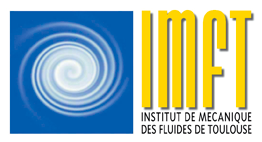Eddy-current based detection pf inclusions and bubbles in liquide metal two-phase flows
Antoine Afflard
Mercredi 10 juillet à 10 h 30 Amphithéâtre Nougaro
Abstract
This thesis is part of CEA’s TECNA project, the aim of which is to develop instruments for detecting and quantifying the presence of bubbles in liquid sodium flows. These instruments are designed to detect any gas leaks in the circuits of sodium-cooled fast breeder reactors, in order to guarantee the safety of the operation. One of the measurement techniques considered involves inducing eddy currents in the flowing liquid, using an alternating magnetic field. Previous work has shown that Eddy-Current Flow Meters (ECFM), using this technique, can not only measure the flow of a metallic liquid in a pipe, but also detect the passage of electrically insulating inclusions (bubbles or particles).
The interaction between the oscillating magnetic field generated by the ECFM and the passage of inclusions in a conductive fluid produces a disturbance in the magnetic field, which is detected by the ECFM. The measured signal then depends on the properties of the inclusions (positions, sizes). This work deals with the detection of electrically insulating inclusions in a liquid metal flow using eddy current perturbation. The aim of this thesis is to develop a two-phase flow loop to study the behavior of gas bubbles in liquid metal in turbulent flow. The aim is also to better understand and model the signals measured by the ECFM linked to the disturbance of eddy currents by the presence of bubbles.
Simulations and an analytical model are developed to better understand the influence of inclusion size and position on the signal. An inverse method is developed to determine the radial position and diameter of an inclusion from the amplitude and phase shift of the perturbation it induces on the ECFM signal. In order to validate the modeling and the inverse method, experiments are carried out using solid particles in motion in a quiescent liquid metal. Subsequently, this method is applied to the characterization of ascending bubble trains in static metal. An experimental loop is specially designed to study the passage of bubbles of controlled diameter in a turbulent flow of liquid metal. The tests carried out validate the modeling of the electromagnetic interaction between the turbulent flow and the bubbles, as well as the response induced in the ECFM. The ECFM response induced by the passage of multiple inclusions is also modeled. For low void fractions, the disturbances induced by the passage of multiple inclusions are obtained by superimposing the individual responses of the inclusions. The results reveal the existence of ECFM configurations that are more sensitive to flow and others that are more sensitive to the presence of inclusions. These models open up promising prospects for the development of an inverse method for measuring the void fraction in a liquid sodium flow.
Keywords : Eddy currents, bubble detection, two-phase flow, liquid metal.
